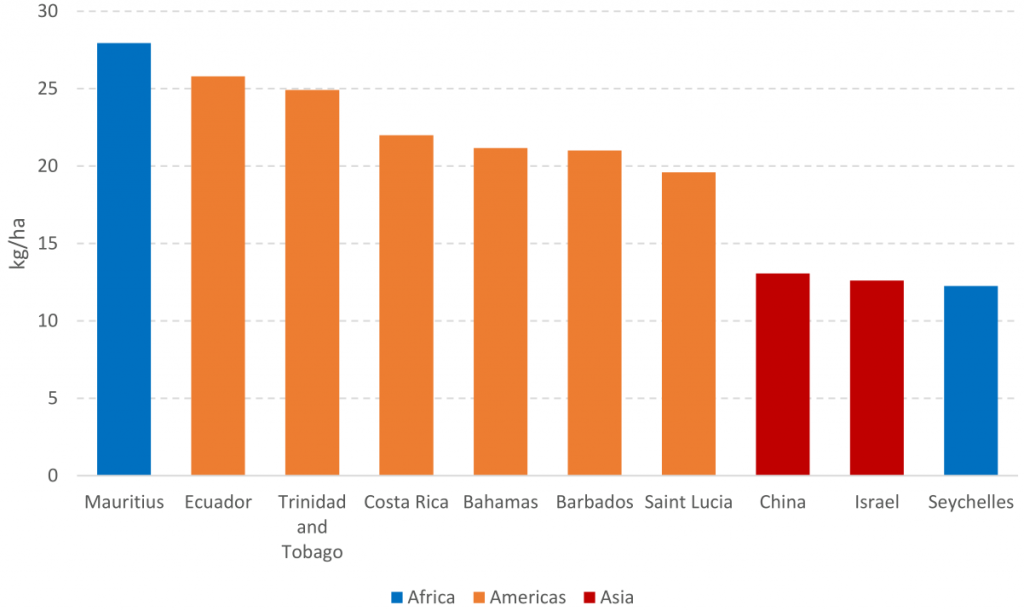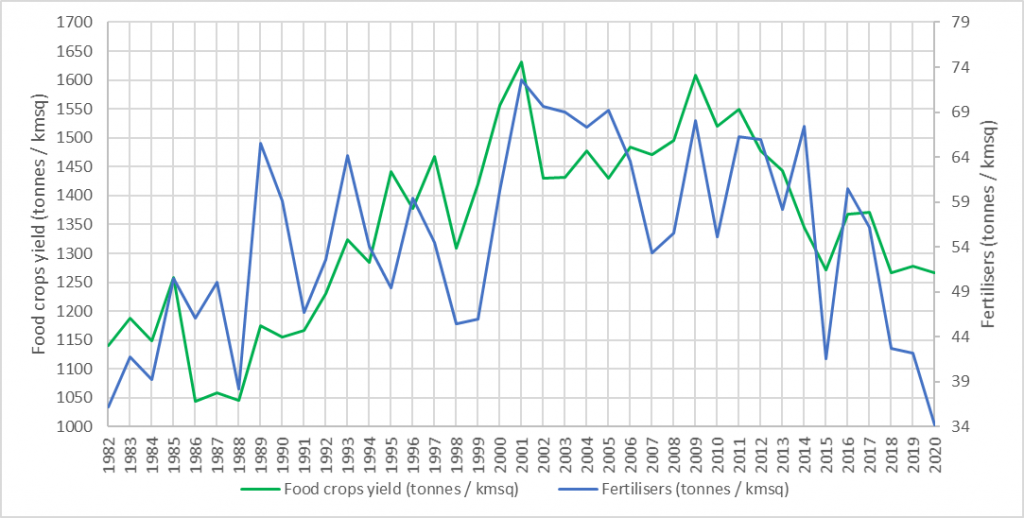Nitin Rughoonauth, Department of Physics, Faculty of Science, University of Mauritius
Mauritius is the biggest user of pesticides per area of cropland in the world. Given the scarcity of research on the impact of continued overuse of pesticides on the environment and people’s health on the island, it is urgent to raise awareness about the possible implications of this issue so we can find ways to avert a major ecological disaster. In this article, Nitin Rughoonauth enquires about the environmental and health impact of pesticides overuse in Mauritius and proposes some possible ways forward.
The latest report from the United Nations Food and Agriculture Organization (FAO) on global trends in pesticide use puts Mauritius at the top of the list of countries that used the most pesticides in 2018 (see Figure 1), with 2795 kg of pesticides used per kmsq of cropland (the latest 2020 statistics gives a record figure of 3418 kg /sqkm, which is a 22.3% increase over the past 3 years).

Figure 1: Top 10 countries for pesticides use per area of cropland in 2018
A priori, most of us may not make sense of those figures, but once we realise that this is over 10 times the amount of pesticides utilised per area in France, and that the use of pesticides in Mauritius has increased fivefold[1] over the past half century (see Figure 2), we may begin to understand the extent of the abuse of pesticides in the agricultural sector on the island.

Figure 2: Agricultural use of pesticides in Mauritius (1971-2020) in kg /kmsq of cropland.
The Overuse of Pesticides in Agriculture
Pesticides (which include insecticides, fungicides and herbicides) are agrochemicals that have proved to be extremely useful in fighting pests and diseases. Given the atmospheric and soil conditions in Mauritius as well as the decline in natural defences (itself mainly caused by pesticides), these would have otherwise proliferated and affected our crops, thus putting our food security and economy at risk. The promotion and expansion agricultural practice in Mauritius, together with an almost complete absence of integrated pest management, have meant that pesticides have been used in often unregulated and disproportionate quantities. The first legislative measures to control the use of pesticides in Mauritius were taken in the 1970s with the passing of the Pesticides Control Act . A Pesticide Control Board was set up to regulate the importation, manufacture, sale and distribution of pesticides, as well as to promote safe pest-control practices. However, extensive surveys[2] carried out among local vegetable and fruit producers and reports by local and international authorities[3] have revealed the extent of a misuse and abuse of pesticides over the years.
Declining Soil Fertility
The potential economic, environmental and public health impacts of high levels of agrochemical use are well known. Soil fertility may be reduced through the adverse effects of excessive pesticide use on beneficial soil microorganisms as well as by extreme leaching of nutrients. Over the years, planters have tried to remedy this situation by using large amounts of chemical fertilisers to maximise food crop yields (amount of food crops per cultivated area) (see Figure 3) while the soil was being depleted of its natural nutrients.

Figure 3: Use of fertilisers and food crops yield in Mauritius (1982-2020) in tonnes /kmsq.
Large increases in use of fertilisers would only contribute to relatively modest increases in food crops yield, which may indicate that cropland has been rendered significantly barren over years due to overuse of pesticides. According to available information, there is, to this day, no facility at the Food and Agricultural Research & Extension Institute for chemical and microbiological analysis of soil to monitor the state of agricultural strata. Over the period 2009-2020, a 49.8% decrease in fertiliser use would in large part account for the 21.3% decline in food crops yield, but the 23.5% increase in pesticide use (see Figure 1) over the same period is intriguing and raises questions about the continued increasing use of pesticides when food crops yield has been decreasing.
Water and Air Contamination
Runoffs of pesticides and fertilisers from treated plantations during heavy rains can contaminate our surface and ground water with toxic chemicals. A 2-year monitoring study funded by the Mauritius Research Council found residues of herbicides washed from cropland in ground and surface water, with traces present almost a year after application. It is known that degradation products of such herbicides could be more important contaminants in soil and water environments[4]. This type of study indicates that no fresh water source in Mauritius is sheltered from pollution by pesticides used on cropland[5]. Pesticide sprays can drift or volatilise from treated areas and contaminate the air. A study investigating the presence of 27 pesticides in air samples collected around cropland areas in the region of Réduit between 2010 and 2018 showed the presence of 12 pesticides, some of which are not legally allowed in Mauritius since 2004. It is known that drift can account for substantial loss in the amount of applied chemical, which can spread over a distance of a few metres to several hundred kilometres, and as much as 80-90% of an applied pesticide can be volatilised within a few days of application. The transportation of pesticides in water and air poses a serious environmental risk since it can lead to spread of contamination and loss of biodiversity in Mauritius [6] .
Inadequate Legislations
Reports from the Ministry of Health and the Ministry of Agro-Industry had, by 2018, revealed an undeniable overuse of pesticides, which prompted the introduction of the Use of Pesticides Act (UoPA) to regulate levels of pesticide residues in agricultural produce. However, frustratingly, the legislation remains insufficient to effectively address the problem of residues in agricultural produce. In 2019, 20% of the 500 agricultural produce samples collected from farm gates, supermarkets and importers contained residues of pesticides (many of them illegal) in excess of legally allowed maximum residue levels (MRLs). The lists of regulated pesticides are not exhaustive (L’express, 2018a) and the MRLs for these pesticides do not cover all fruits and vegetables, e.g. nearly 40% of imported fruits (apples, pears, kiwifruits, peaches and apricots) are not concerned (L’express, 2018b).
At present, three legislative acts – the Food Act (FA) (including the Food Regulations), the Dangerous Chemicals Control Act (DCCA), and the UoPA – are together meant to regulate the importation, processing, production, distribution and use of pesticides. However, the FA and UoPA were passed by different ministries (the Ministry of Health and Wellness (MoHW), and the Ministry of Agro-Industry and Food Security, respectively), and both happen to regulate separate (but not mutually exclusive) lists of pesticides. This may lead to institutional encroachment between the Pesticides Regulatory Office (PRO) (set up under the UoPA) and the MoHW. More worryingly, of the 54 pesticides allowed by the UoPA for use on fresh fruits and vegetables, only 31 are overseen by the DCCA. As such, there is a priori no control on the importation and distribution of the other 23 pesticides, half of which are classified as hazardous), while 17 (of which half are hazardous) are not even inventoried in the FAO Codex Alimentarius[7].
The DCCA restricts 112 pesticides, but the MRLs of only 54 (about 50%) of those are provided in the UoPA, which is a serious inconsistency. Even more confusing is the fact that, of the 84 pesticides regulated by the FA, 20 of them are outright prohibited by the DCCA, while 37 are not listed in the Codex. Furthermore, the Guide Agricole, which is published for the benefit of producers, recommends the use of 48 pesticides, of which only 29 are regulated by the UoPA while 11 are neither listed as prohibited/restricted under the DCCA nor regulated by the UoPA. Finally, penalties for similar types of offences under those acts differ. The incongruencies and fragmentation in the regulatory framework need to be addressed urgently if we are to effectively regulate pesticide use in Mauritius.
There is a real concern about the number of pesticides that are used on certain agricultural produce. This directly and worryingly links with the common practice, by a significant number of producers, of mixing pesticides because they find such “cocktails” more effective in fighting certain pests. The UoPA provides MRLs for a number of pesticides that could be used on a number of fruits and vegetables, but this could easily be construed by planters as encouraging mixing of pesticides. For example, no less than 42 pesticides can be used on tomatoes, 38 on potatoes, 30 on green beans, and 25 on onions, to name a few. The multiplicity of pesticides, together with the widespread tendency of producers to apply pesticides to their crops several times a year and not respect dosages, can lead to serious toxicity risks, to pests developing resistance against pesticides, and the pests’ predators being eliminated, which lead to a greater use of more pesticides. This may explain why the use of pesticides has increased to such an extent over the years (Figure 2).
Overuse of pesticides and health
That the indiscriminate use of pesticides is a health hazard is well documented[8]. The accumulated amount of pesticides used in Mauritius over the past half century or more is cause for serious concern for the population[9], given the largely undocumented but prolonged exposure to the cumulative effects of pesticides and their residues, derivatives, and metabolites. The causal link between exposure to certain pesticides and incidence of some forms of cancer is still being studied since it is difficult to control for other possible causes. However, it is possible to establish fairly robust correlations between increase in use of pesticides and the development of some cancers, particularly those of the brain, breast, colon rectum, kidney, prostate, as well as leukemia.
Correlation coefficients between use of pesticides and age-standardised rates (ASR) of incidence of certain forms of cancer in males and females in Mauritius (Pat et al., 2019) were found (see Figures 4 & 5) for the period 1991 – 2015 (with data for 2020 included). Statistically significant (p<0.05) correlations (see coefficients in parentheses in the chart legends – a coefficient of 1 means perfect correlation) can be seen between use of pesticides and cancers of colon rectum, pancreas, brain, prostate, kidney, and leukemia in males, while in females, these cancer forms are lung, breast, corpus uteri, colon rectum, and leukemia. These suggest connections that seem to corroborate findings from studies and systematic literature reviews on the link between the development of some cancer types and pesticides. The Government acknowledged that the wide use of pesticides needed better monitoring and control as part of a National Cancer Control Programme Action Plan[10] . The latest data shows that Mauritius ranks in the top three in the African region in incidence of cancers of the breast, corpus uteri, colon rectum, and leukaemia. It is urgent that extensive research studies be carried out to explore the possibility of causal relations.

Figure 4: Cancer incidence (ASR (per 100,000)) & use of pesticides (kg /kmsq) – MALE

Figure 5: Cancer incidence (ASR (per 100,000)) & use of pesticides (kg /kmsq) – FEMALE
A Threat to Food Security
For decades, pesticide overuse in Mauritius has been the norm. The recent FAO report sets the alarm bells ringing with food safety as a national priority under threat. Here are three proposed ways forward:
- A review and harmonisation of existing legislations are needed to rationalise and strengthen the judicial and institutional framework that regulates the importation, production, distribution, and use of pesticides in agriculture.
- Authorities concerned should invest more in training planters in sound agricultural practices and systematically monitor the presence of pesticide residues in agricultural produce.
- Three years after the promulgation of the UoPA, no Pesticides Code of Practice has been put in place by the PRO, and there seems to be no indication that Mauritian authorities follow guidelines of the FAO and WHO International Code of Conduct on Pesticide Management[11]. Despite being the signatory of a number of conventions and protocols[12], Mauritius has not respected its engagements. Mauritian authorities need to better honour their commitments and work towards ensuring the systematic implementation, compliance, and effective monitoring of these commitments.
Ultimately, unless we are able to truly understand what is being used on the food we eat and what goes into the water and air that we drink and breathe, we will not feel safe.
I dedicate this article to Didine, who so lovingly taught me to be mindful of and care deeply for the environment of this precious island, and the one on which she was born, Rodrigues.
Main Photo by Arjun MJ on Unsplash
Charles Telfair Centre is an independent nonpartisan not for profit organisation and does not take specific positions. All views, positions, and conclusions expressed in our publications are solely those of the author(s).
[1] Statistics Mauritius (SM) (1982 – 2020). Digest of Agricultural Statistics. URL: https://bit.ly/3xML7oR
Statistics Mauritius (SM) (2021). Environment Statistics 2020. URL: https://bit.ly/2VGo6Gz
[2] Fagoonee, I. (1984). Pertinent aspects of pesticide usage in Mauritius. Insect Science and Its Application, 5(3), 203 – 212. URL: https://bit.ly/3gbFD0X
Fagoonee, I. (1987). Pesticides practice among vegetable growers in Mauritius. In Management of Pests and Pesticides (pp 175 – 181). CRC Press. URL: https://bit.ly/3iAhPVN
Le Bellec, F., Scorbiac, M. & Sauzier, J. (2017). Les pratiques phytosanitaires des producteurs de légumes de l’île Maurice: impacts et perspectives de changement. Cahiers Agricultures, 26, 55001. URL: https://bit.ly/3Aydbhu
[3] World Bank (WB) (1988). Economic development with environmental management strategies for Mauritius. Report no. 7264-MAS. URL: https://bit.ly/3iBUrr5
Ministry of Environment and Sustainable Development (MoESD) (2011). Mauritius Environment Outlook Report 2011. Government of Mauritius. URL: https://bit.ly/3CCmzSO
Ministry of Health and Quality of Life (MoHQL) (2014). National chemicals profile of the Republic of Mauritius. URL: https://bit.ly/3yLcfpu
[4] e.g. see Baluch et al. (1993)
[5] See Li (2016) for a comparative analysis of the worryingly high maximum allowed concentration levels of pesticides in drinking water in Mauritius
[6] Safford, R.J. & Jones, C.G. (1997). Did organochlorine pesticide use cause declines in Mauritian forest birds? Biodiversity and Conservation, 6, 1445 – 1451. URL: https://bit.ly/3yGiDxZ
[7] The Codex is an internationally recognised benchmark for food safety standards.
[8] Sarkar, S., Gil, J.D.B., Keeley, J. & Jansen, K. (2021). The use of pesticides in developing countries and their impact on health and the right to food. European Union. URL: https://bit.ly/3AKMbvb
[9] Laniece, I. (1995). Pesticide usage and associated health hazards in Mauritius – Descriptive report. URL: https://bit.ly/3AES2SI
Ministry of Environment and Sustainable Development (MoESD) (2011). Mauritius Environment Outlook Report 2011. Government of Mauritius. URL: https://bit.ly/3CCmzSO
[10] See also Ministry of Health and Quality of Life (MoHQL). (2009). National Plan of Action for Nutrition (2009 – 2010). URL: https://bit.ly/3D78gpN
[11] Food and Agricultural Organization (FAO) (2021). Codex Alimentarius International Food Standards – Pesticides Index. URL: https://bit.ly/37GuoZq
Food and Agricultural Organization & World Health Organization (FAO & WHO) (2014). The International Code of Conduct on Pesticide Management. URL: https://bit.ly/3gw5kcq
[12] e.g. the Rotterdam Convention (since 2005, to multilaterally promote shared responsibilities in relation to importation of hazardous chemicals); the Stockholm Convention on persistent organic pollutants (since 2001, although Mauritius still consents to import the banned DDT); the Cartagena Protocol on Biosafety (since 1992); and the Basel Convention (since 2004, to prevent transfer of hazardous waste from developed to less developed countries).

